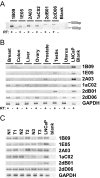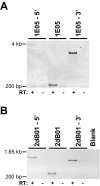Novel expressed sequences identified in a model of androgen independent prostate cancer
- PMID: 17257419
- PMCID: PMC1790899
- DOI: 10.1186/1471-2164-8-32
Novel expressed sequences identified in a model of androgen independent prostate cancer
Abstract
Background: Prostate cancer is the most frequently diagnosed cancer in American men, and few effective treatment options are available to patients who develop hormone-refractory prostate cancer. The molecular changes that occur to allow prostate cells to proliferate in the absence of androgens are not fully understood.
Results: Subtractive hybridization experiments performed with samples from an in vivo model of hormonal progression identified 25 expressed sequences representing novel human transcripts. Intriguingly, these 25 sequences have small open-reading frames and are not highly conserved through evolution, suggesting many of these novel expressed sequences may be derived from untranslated regions of novel transcripts or from non-coding transcripts. Examination of a large metalibrary of human Serial Analysis of Gene Expression (SAGE) tags demonstrated that only three of these novel sequences had been previously detected. RT-PCR experiments confirmed that the 6 sequences tested were expressed in specific human tissues, as well as in clinical samples of prostate cancer. Further RT-PCR experiments for five of these fragments indicated they originated from large untranslated regions of unannotated transcripts.
Conclusion: This study underlines the value of using complementary techniques in the annotation of the human genome. The tissue-specific expression of 4 of the 6 clones tested indicates the expression of these novel transcripts is tightly regulated, and future work will determine the possible role(s) these novel transcripts may play in the progression of prostate cancer.
Figures



References
-
- Jemal A, Murray T, Ward E, Samuels A, Tiwari RC, Ghafoor A, Feuer EJ, Thun MJ. Cancer statistics, 2005. CA Cancer J Clin. 2005;55:10–30. - PubMed
-
- Petrylak DP, Tangen CM, Hussain MH, Lara PN, Jr., Jones JA, Taplin ME, Burch PA, Berry D, Moinpour C, Kohli M, Benson MC, Small EJ, Raghavan D, Crawford ED. Docetaxel and estramustine compared with mitoxantrone and prednisone for advanced refractory prostate cancer. N Engl J Med. 2004;351:1513–1520. doi: 10.1056/NEJMoa041318. - DOI - PubMed
-
- Sadar MD, Akopian VA, Beraldi E. Characterization of a New in Vivo Hollow Fiber Model for the Study of Progression of Prostate Cancer to Androgen Independence. Mol Cancer Ther. 2002;1:629–637. - PubMed
Publication types
MeSH terms
Substances
Associated data
- Actions
- Actions
- Actions
- Actions
- Actions
- Actions
- Actions
- Actions
- Actions
- Actions
- Actions
- Actions
- Actions
- Actions
- Actions
- Actions
- Actions
- Actions
- Actions
- Actions
- Actions
- Actions
- Actions
- Actions
- Actions
- Actions
- Actions
- Actions
- Actions
- Actions
- Actions
- Actions
- Actions
- Actions
- Actions
- Actions
- Actions
- Actions
- Actions
- Actions
- Actions
- Actions
- Actions
- Actions
- Actions
- Actions
- Actions
- Actions
- Actions
- Actions
- Actions
- Actions
- Actions
- Actions
- Actions
- Actions
- Actions
- Actions
- Actions
- Actions
- Actions
- Actions
- Actions
- Actions
- Actions
- Actions
- Actions
- Actions
- Actions
- Actions
- Actions
- Actions
- Actions
- Actions
- Actions
- Actions
- Actions
- Actions
- Actions
- Actions
- Actions
- Actions
- Actions
- Actions
- Actions
- Actions
- Actions
- Actions
- Actions
- Actions
- Actions
- Actions
- Actions
- Actions
- Actions
- Actions
- Actions
- Actions
- Actions
- Actions
- Actions
- Actions
- Actions
- Actions
- Actions
- Actions
- Actions
- Actions
- Actions
- Actions
- Actions
- Actions
- Actions
- Actions
- Actions
- Actions
- Actions
- Actions
- Actions
- Actions
- Actions
- Actions
- Actions
- Actions
- Actions
- Actions
- Actions
- Actions
- Actions
- Actions
- Actions
- Actions
- Actions
- Actions
- Actions
- Actions
- Actions
- Actions
- Actions
- Actions
- Actions
- Actions
- Actions
- Actions
- Actions
- Actions
- Actions
- Actions
- Actions
- Actions
- Actions
- Actions
- Actions
- Actions
- Actions
- Actions
- Actions
- Actions
- Actions
- Actions
- Actions
- Actions
- Actions
- Actions
- Actions
- Actions
- Actions
- Actions
- Actions
- Actions
- Actions
- Actions
- Actions
- Actions
- Actions
- Actions
- Actions
- Actions
- Actions
- Actions
- Actions
- Actions
- Actions
- Actions
- Actions
- Actions
- Actions
- Actions
- Actions
- Actions
- Actions
- Actions
- Actions
- Actions
- Actions
- Actions
- Actions
- Actions
- Actions
- Actions
- Actions
- Actions
- Actions
- Actions
- Actions
- Actions
- Actions
- Actions
- Actions
- Actions
- Actions
- Actions
- Actions
- Actions
- Actions
- Actions
- Actions
- Actions
- Actions
- Actions
- Actions
- Actions
- Actions
- Actions
- Actions
- Actions
- Actions
- Actions
- Actions
- Actions
- Actions
- Actions
- Actions
- Actions
- Actions
- Actions
- Actions
- Actions
- Actions
LinkOut - more resources
Full Text Sources
Medical

